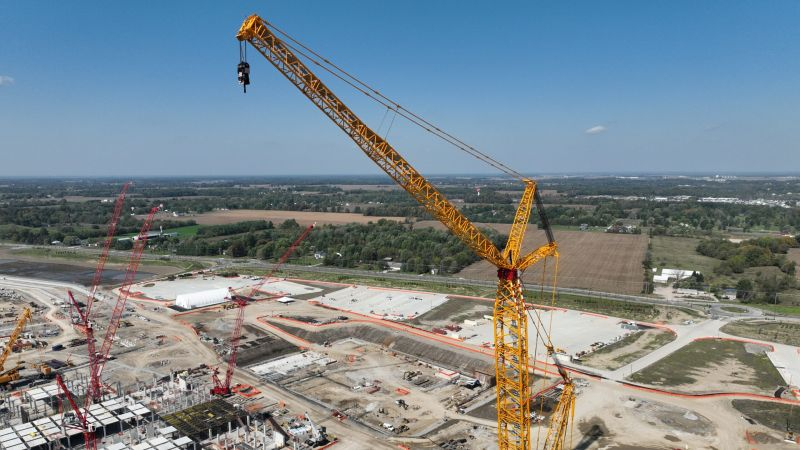Intel in talks with TSMC to put its factories under management


The news about the possible participation of Taiwanese TSMC in the operational management of Intel’s American enterprises developed systematically during the past week, and by the end of the week it became known that American officials, as well as the management of both companies, were involved in the negotiations.


Image Source: Intel
In any case, The New York Times published a story on Saturday claiming that interim executive chairman Frank Yeary has been in talks for months with both the U.S. government and the Taiwanese contract chipmaker TSMC to help restructure Intel’s own manufacturing business.
According to sources familiar with the situation, TSMC could gain control of Intel’s manufacturing assets along with a stake in the unit, with the remaining shares being distributed among a consortium of investors that would include both financial and technology sector companies.
The Trump administration is reportedly pushing TSMC to participate in this deal, and the nominee for the post of US Secretary of Commerce, Howard Lutnick, has been entrusted with one of the most important roles in these negotiations. The future Secretary considers this task a serious challenge and treats this mission with all responsibility.
The structure of the possible deal has not yet been determined, sources say. TSMC may limit itself to operational management of Intel’s American plants in Oregon, Arizona and New Mexico, but one scenario includes transferring control over plants in Ireland and Israel. In this case, we are talking only about those Intel plants that process silicon wafers.
Negotiations between Intel and TSMC began last year. The initiative came from the board of directors of the former company. In January of this year, TSMC CEO C.C. Wei met with Lutnick and Yiri to discuss a possible cooperation scheme. The latter of the participants in that meeting subsequently regularly approached the future US Secretary of Commerce with relevant ideas.
For the Trump administration, these negotiations pose a dilemma between saving Intel by handing over advanced American factories to the Taiwanese company and finding alternative solutions. Some experts estimate that even with significant financial support from the US government, it will be difficult to revive Intel’s manufacturing business.
Trump, as is well known, did not speak very flatteringly about political and economic interaction with Taiwan. He proposed replacing subsidies in favor of Taiwanese companies with a “stick” in the form of increased customs duties, demanding more money from the island for its security, and he also did not like the concentration of chip manufacturing enterprises in Taiwan. Trump accused the island of literally “stealing the US semiconductor industry.” Lutnick personally considers the “CHIP Act,” which provides for the allocation of subsidies for the construction of semiconductor industry enterprises in the US, important and necessary.
The Taiwanese authorities need the patronage of the United States in strategic terms, and they consider the protection of the local semiconductor industry to be the motive that could interest American partners. The formal president of the island, Lai Ching-te, made it clear this week that the region’s semiconductor industry would develop a strategy that would also suit the political leadership of the United States. In principle, TSMC itself is participating in the construction of three enterprises in the state of Arizona and is laying claim to significant subsidies from the US budget, so it could take on the additional burden of Intel’s enterprises only if there are compelling reasons for doing so.
Since last year, Intel has been trying to give its manufacturing business more autonomy, but some analysts believe that breaking up the company in this way would leave Intel vulnerable and susceptible to acquisition. In fact, under certain conditions, Intel would simply cease to exist. Intel’s Foundry division brought in $13.4 billion for the parent company last year, while customer revenue fell by 60%. It won’t be easy to turn things around.
Recent Posts
Nissan Leaf EV to Become NACS-Ported Compact Crossover in Third Generation
Nissan Leaf can rightfully be considered a long-liver of the electric car market, since the…
OpenAI expects to more than triple its revenue this year and then double it next year.
OpenAI, the market leader in generative artificial intelligence systems, remains nominally a startup, its financial…
OpenAI Decides to Hold 4o Image Generation Launch for Free Users
OpenAI has been forced to delay the release of ChatGPT's built-in image generator for free…
1440p and 240Hz for just $200: Xiaomi updates the 27-inch Redmi G27Q gaming monitor
Xiaomi continues to update its Redmi G27Q gaming monitor every year. The model was first…
Beware, Android is shutting down: OS development will cease to be public, but there is no reason to panic
Android device makers can significantly customize the look and feel of the operating system, but…
Fake GeForce RTX 4090s with RTX 3090 chips have started popping up in China — craftsmen are even changing the GPU markings
In China, scammers have started selling GeForce RTX 3090 graphics cards, passing them off as…